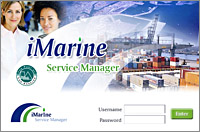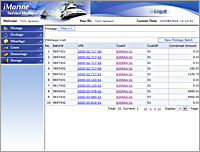 |
Port of Los Angeles: Billing System Conversion and Analysis
The Client
The Port of Los Angeles is the nation?s largest port, encompassing 7,500 acres, 43 miles of waterfront and featuring 26 cargo
terminals, including dry and liquid bulk, container, breakbulk, automobile and omni facilities. Combined, these terminals handle
nearly 150 million metric revenue tons of cargo annually. Last year, the Port moved 7.4 million TEUs, establishing a new
national container record.
As a proprietary and self-supporting department, the Port is not supported by taxes. Classified as a Landlord Port, the Port of
Los Angeles derives its income from fees for shipping services including wharfage, dumerrage, dockage, pilotage, storage,
space and crane leases, permits, penalties, royalties and other Port services.

The Challenge
The challenges that necessitated this large-scale project encompassed both business process, as well as technical elements.
On the business process side, the Port was facing a projected threefold increase in volume over the next 15 years. Because the
current 33 year-old legacy billing system evolved organically over time without deliberate planning, it had become burdened
with older applications, outdated paradigms (Tariff vs. TEU), inefficient system architecture, disparate technologies, manual
intervention points and a lack of system standards. While marginally sufficient for its current throughput, this system lacked the
efficiency necessary to absorb any significant changes in volume. From a technical standpoint, the system was running on VSE
2.3, which was no longer supported by IBM. Operating such a mission-critical system on an unsupported platform was deemed
too high a risk. Compounding this challenge was the fact that Port management needed to implement a scalable and adaptable
solution quickly.
The Solution
Saga Technologies called upon key members of its Mainframe Team to focus on completing the critical conversion phase of the
project. By designating 4 on-site consultants at the Port, the Saga team was able to successfully upgrade the mainframe billing
applications within 5 months ? representing more than a 50% reduction in time from the original 12 month plan. The
immediate result was a high quality conversion that mitigated the risk of operating on an unsupported platform, achieved
without increasing the original project budget and without interrupting business operations.
Concurrently, members of the .NET and Business Intelligence teams performed an analysis on Keymaster, the primary data
entry tool within this system. The objective of this project was to formulate a plan and recommendation for replacing
Keymaster with a web-enabled alternative, thus laying the groundwork for future upgrades as required by the Port?s
ever-increasing throughput. As part of the analysis, the Saga team interviewed all levels of users on-site to conduct gap
analysis between the ?as-is? process and ?to be? process flow. Off-site, the project team leader attended AAPA (American
Association of Port Authorities) meetings in Los Angeles and Chicago to gain a deeper understanding of technical and process
issues, trends and solutions related to the port industry in general. The efforts culminated in a working proposal to re-architect
the overall system utilizing a milestone-based implementation approach. The team also presented a prototype of an envisioned
portal that could be adopted to support the processes included in the analysis.

The Benefits
By updating the billing system upon which it operates, the Port has accomplished one of its most critical initiatives. Of all
systems in the Port, the billing system is the one directly responsible for the revenue that supports its day-to-day operations.
Having converted to an updated and supported platform, the Port has achieved the immediate benefit of improved stability for
the system as a whole, while drastically reducing the risk of down time in the event of a system problem or failure. At the
same time, this project represents the first step in preparing the Port for future growth. Re-engineered with scalability,
adaptability and automation as the focal points, a web-enabled billing system like that envisioned by Saga Technologies would
help to solidify the Port of Los Angeles as one of the leading ports in the world.
Technologies
Utilized
COBOL LE, Report Writer, CICS/VSAM, Vollie, DataCom, VSE 2.6, Visual Studio.NET, MS SQL Server 2000 and Infragistics
NetAdvantage 5.1
‹‹ Back
to Case Studies
|